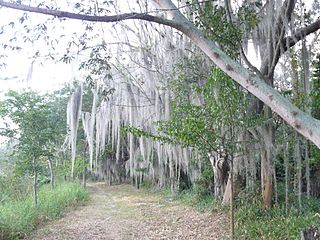
Angraecum, also known as comet orchid, is a genus of the family Orchidaceae native to tropical and South Africa, as well as Sri Lanka. It contains 223 species.

The Magdalena River is the main river of Colombia, flowing northward about 1,528 kilometres (949 mi) through the western half of the country. It takes its name from the biblical figure Mary Magdalene. It is navigable through much of its lower reaches, in spite of the shifting sand bars at the mouth of its delta, as far as Honda, at the downstream base of its rapids. It flows through the Magdalena River Valley.

Melanargia galathea, the marbled white, is a medium-sized butterfly in the family Nymphalidae. Despite its common name and appearance, this butterfly is one of the "browns", of the subfamily Satyrinae.
The Bunjako barb is a species of cyprinid fish.
The Magdalena spiny rat is a species of rodent in the family Echimyidae. It is endemic to Colombia.
Xyliphius is a genus of banjo catfishes from South America.
Xyliphius barbatus is a species of banjo catfish that is endemic to Argentina where it is found in the Paraguay-Paraná River system basin. It grows to a length of 9.2 cm.
Xyliphius kryptos is a species of banjo catfish endemic to Venezuela where it is found in the Lake Maracaibo basin. It grows to a length of 11.0 cm.

Hoplosternum magdalenae is a species of catfish of the family Callichthyidae. It is found west of the Andes, in the Lake Maracaibo basin in Venezuela, and in the drainages of Sinu River and Magdalena River in Colombia.

Aechmea magdalenae is a flowering plant in the Bromeliaceae family. It is also known as ixtle. This species is native to Central America, southern Mexico, Colombia and Ecuador. The specific epithet magdalenae comes from the place it was discovered, the Rio Magdalenae Valley in Colombia. The long green leaves feature fierce spines and may reach about 2.5 meters tall. In nature, it is found in moist and swampy woods. The flowers are red and give way to edible fruits.

Stigmella magdalenae is a moth of the family Nepticulidae. It is found from Scandinavia and Finland to the Pyrenees, Italy and Bulgaria, and from Ireland to central Russia and Ukraine.

The Laguna de Sonso Nature Reserve is located in the Valle del Cauca Department of Colombia. It contains the last extensive remnant of original natural wetland remaining in the Cauca River Valley in western Colombia, and was declared a nature reserve in October 1978. It comprises a series of marshes and lagoons on the east bank of the Cauca River, between the municipalities of Buga, Yotoco and Guacari. It has an area of 2,045 ha (7.90 sq mi), lying at an altitude of 935 m (3,068 ft). The wetlands are affected by the introduced water hyacinth. The reserve has been designated as a protected Ramsar site since 2017.
Paraclinus magdalenae, the Magdalena blenny, is a species of labrisomid blenny only known from around Isla Margarita in Magdalena Bay on the coast of Baja California Sur, where it is found at depths of around 18 to 21 metres.
Xera is a stick insect genus in the family Pseudophasmatidae.
Hewitsonia magdalenae is a butterfly in the family Lycaenidae. It is found in the Democratic Republic of the Congo.

Potamotrygon magdalenae, the Magdalena River stingray, is a species of freshwater fish in the family Potamotrygonidae. It is found only in the Magdalena and Atrato basins in Colombia, but it is locally abundant and among the predominant fish species in its range. It is a small species of stingray with a typical disc width of about 20 cm (8 in), although it can reach up to 35 cm (14 in).
The Missa Sanctae Mariae Magdalenae is a mass composed by English composer William Lloyd Webber in 1979 for choir and organ.
Patasola is an extinct genus of New World monkeys from the Middle Miocene. Its remains have been found at the Konzentrat-Lagerstätte of La Venta in the Honda Group of Colombia. The type species is Patasola magdalenae.
Mezobromelia magdalenae, synonym Cipuropsis magdalenae, is a species of flowering plant in the family Bromeliaceae, native to Colombia. It was first described by Lyman Bradford Smith in 1963 as Vriesea magdalenae.








